Unit 2 Marketing Essentials: Marketing Concepts, Strategy & Relations
VerifiedAdded on 2023/06/18
|15
|4397
|488
Report
AI Summary
This report provides an overview of marketing essentials, including key concepts, the role of a marketing manager, and the influence of marketing on other departments. It analyzes the value of marketing within an organization and explores different marketing processes such as Analysis, Planning, Implementation, and Control. The report also includes a briefing paper that compares Ford and Jeep, two companies in the same competitive market, and how they apply the 7Ps marketing mix to achieve business objectives. Furthermore, the report presents a marketing plan with goals, objectives, tactical action plans, and measures for monitoring and evaluating progress. Desklib is a website where students can find similar solved assignments and study resources.
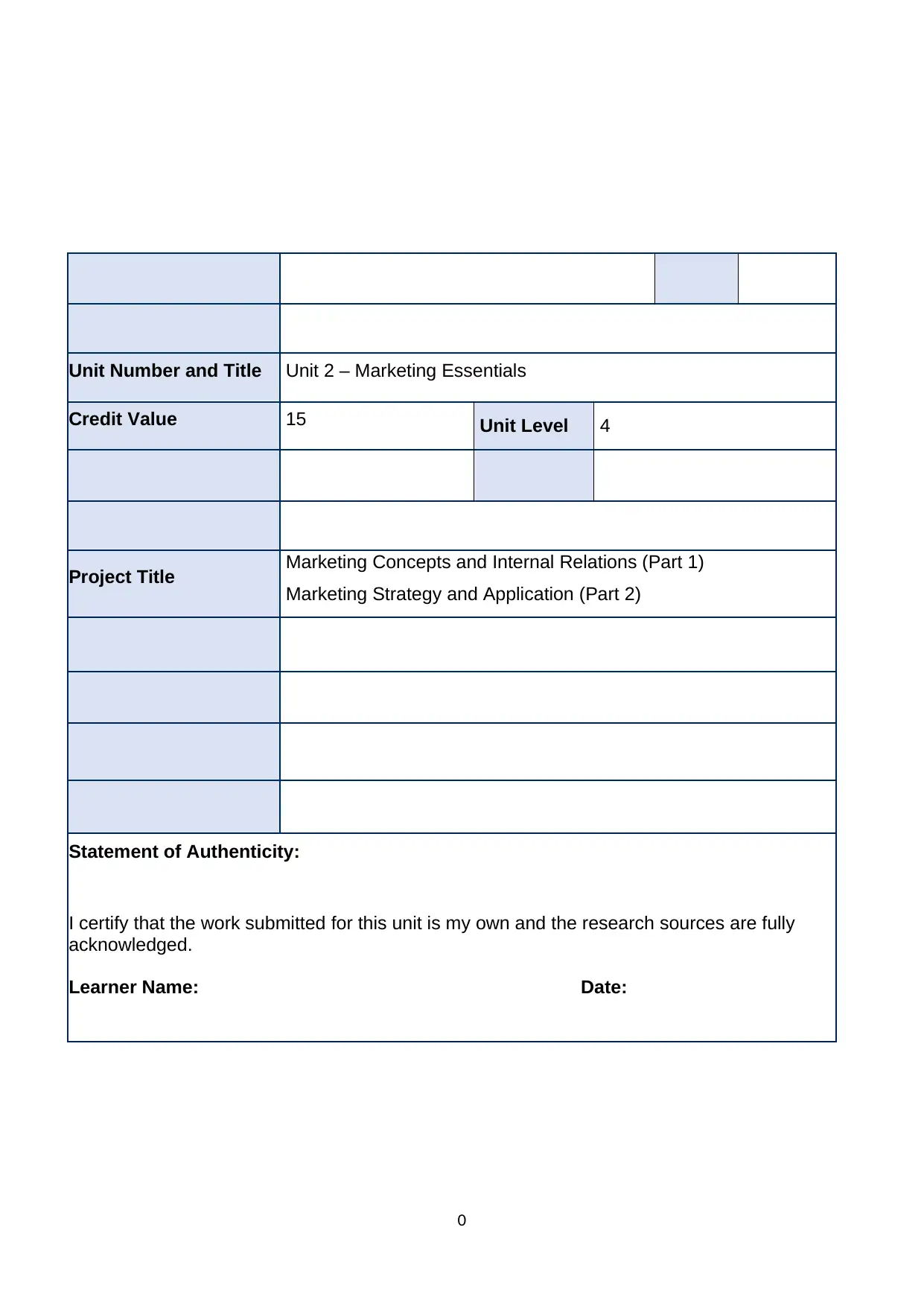
Unit Number and Title Unit 2 – Marketing Essentials
Credit Value 15 Unit Level 4
Project Title Marketing Concepts and Internal Relations (Part 1)
Marketing Strategy and Application (Part 2)
Statement of Authenticity:
I certify that the work submitted for this unit is my own and the research sources are fully
acknowledged.
Learner Name: Date:
0
Credit Value 15 Unit Level 4
Project Title Marketing Concepts and Internal Relations (Part 1)
Marketing Strategy and Application (Part 2)
Statement of Authenticity:
I certify that the work submitted for this unit is my own and the research sources are fully
acknowledged.
Learner Name: Date:
0
Paraphrase This Document
Need a fresh take? Get an instant paraphrase of this document with our AI Paraphraser
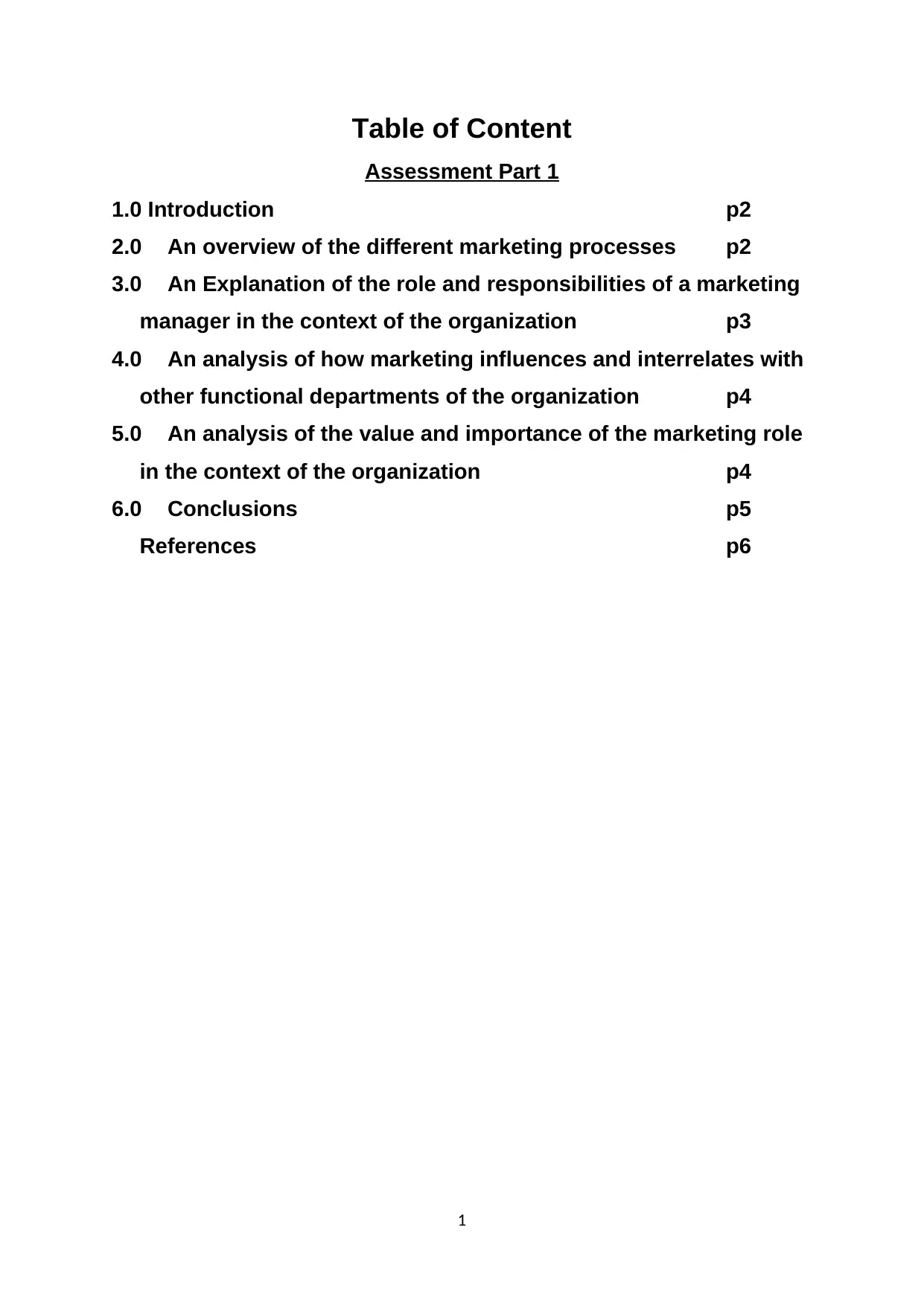
Table of Content
Assessment Part 1
1.0 Introduction p2
2.0 An overview of the different marketing processes p2
3.0 An Explanation of the role and responsibilities of a marketing
manager in the context of the organization p3
4.0 An analysis of how marketing influences and interrelates with
other functional departments of the organization p4
5.0 An analysis of the value and importance of the marketing role
in the context of the organization p4
6.0 Conclusions p5
References p6
1
Assessment Part 1
1.0 Introduction p2
2.0 An overview of the different marketing processes p2
3.0 An Explanation of the role and responsibilities of a marketing
manager in the context of the organization p3
4.0 An analysis of how marketing influences and interrelates with
other functional departments of the organization p4
5.0 An analysis of the value and importance of the marketing role
in the context of the organization p4
6.0 Conclusions p5
References p6
1
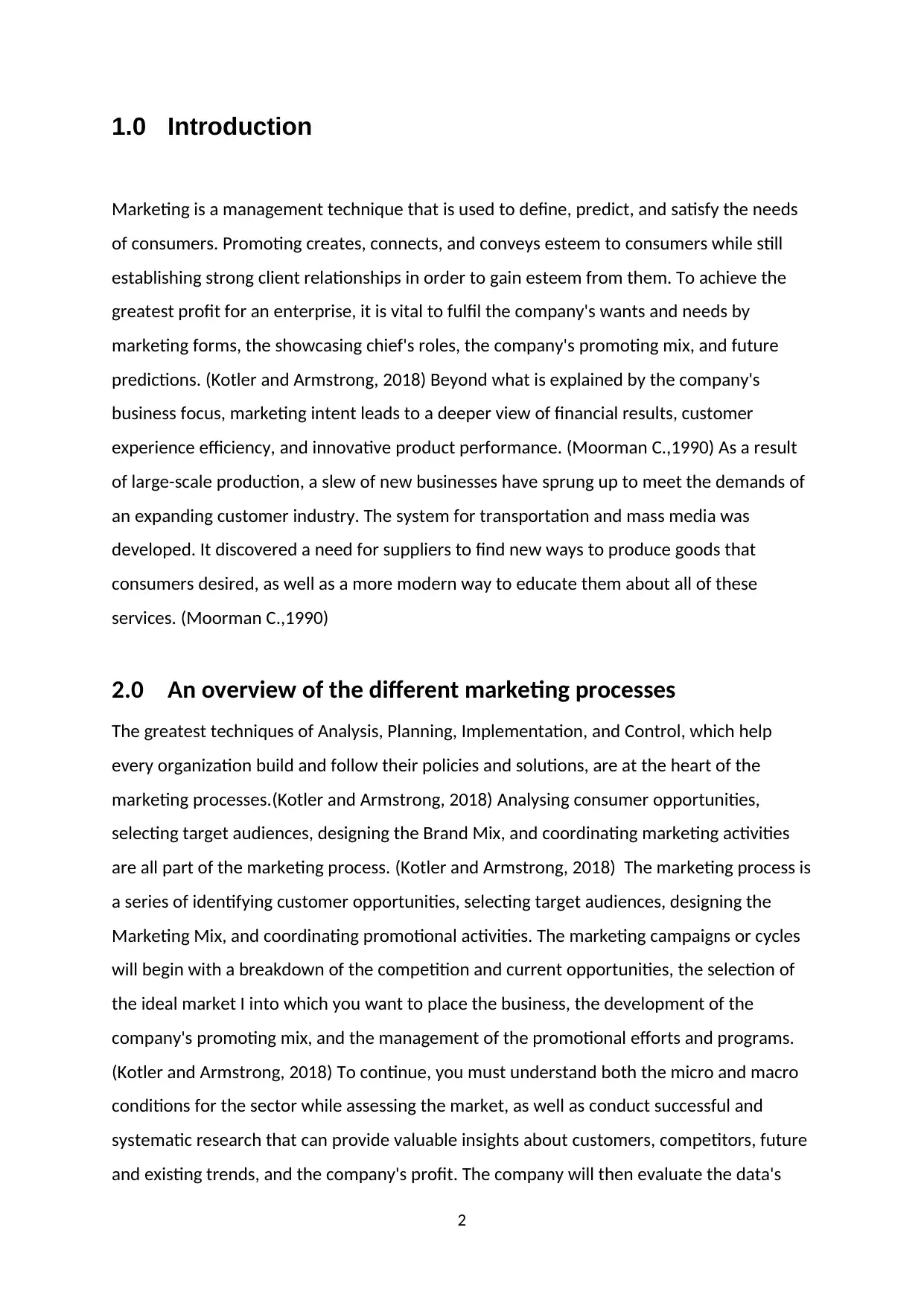
1.0 Introduction
Marketing is a management technique that is used to define, predict, and satisfy the needs
of consumers. Promoting creates, connects, and conveys esteem to consumers while still
establishing strong client relationships in order to gain esteem from them. To achieve the
greatest profit for an enterprise, it is vital to fulfil the company's wants and needs by
marketing forms, the showcasing chief's roles, the company's promoting mix, and future
predictions. (Kotler and Armstrong, 2018) Beyond what is explained by the company's
business focus, marketing intent leads to a deeper view of financial results, customer
experience efficiency, and innovative product performance. (Moorman C.,1990) As a result
of large-scale production, a slew of new businesses have sprung up to meet the demands of
an expanding customer industry. The system for transportation and mass media was
developed. It discovered a need for suppliers to find new ways to produce goods that
consumers desired, as well as a more modern way to educate them about all of these
services. (Moorman C.,1990)
2.0 An overview of the different marketing processes
The greatest techniques of Analysis, Planning, Implementation, and Control, which help
every organization build and follow their policies and solutions, are at the heart of the
marketing processes.(Kotler and Armstrong, 2018) Analysing consumer opportunities,
selecting target audiences, designing the Brand Mix, and coordinating marketing activities
are all part of the marketing process. (Kotler and Armstrong, 2018) The marketing process is
a series of identifying customer opportunities, selecting target audiences, designing the
Marketing Mix, and coordinating promotional activities. The marketing campaigns or cycles
will begin with a breakdown of the competition and current opportunities, the selection of
the ideal market I into which you want to place the business, the development of the
company's promoting mix, and the management of the promotional efforts and programs.
(Kotler and Armstrong, 2018) To continue, you must understand both the micro and macro
conditions for the sector while assessing the market, as well as conduct successful and
systematic research that can provide valuable insights about customers, competitors, future
and existing trends, and the company's profit. The company will then evaluate the data's
2
Marketing is a management technique that is used to define, predict, and satisfy the needs
of consumers. Promoting creates, connects, and conveys esteem to consumers while still
establishing strong client relationships in order to gain esteem from them. To achieve the
greatest profit for an enterprise, it is vital to fulfil the company's wants and needs by
marketing forms, the showcasing chief's roles, the company's promoting mix, and future
predictions. (Kotler and Armstrong, 2018) Beyond what is explained by the company's
business focus, marketing intent leads to a deeper view of financial results, customer
experience efficiency, and innovative product performance. (Moorman C.,1990) As a result
of large-scale production, a slew of new businesses have sprung up to meet the demands of
an expanding customer industry. The system for transportation and mass media was
developed. It discovered a need for suppliers to find new ways to produce goods that
consumers desired, as well as a more modern way to educate them about all of these
services. (Moorman C.,1990)
2.0 An overview of the different marketing processes
The greatest techniques of Analysis, Planning, Implementation, and Control, which help
every organization build and follow their policies and solutions, are at the heart of the
marketing processes.(Kotler and Armstrong, 2018) Analysing consumer opportunities,
selecting target audiences, designing the Brand Mix, and coordinating marketing activities
are all part of the marketing process. (Kotler and Armstrong, 2018) The marketing process is
a series of identifying customer opportunities, selecting target audiences, designing the
Marketing Mix, and coordinating promotional activities. The marketing campaigns or cycles
will begin with a breakdown of the competition and current opportunities, the selection of
the ideal market I into which you want to place the business, the development of the
company's promoting mix, and the management of the promotional efforts and programs.
(Kotler and Armstrong, 2018) To continue, you must understand both the micro and macro
conditions for the sector while assessing the market, as well as conduct successful and
systematic research that can provide valuable insights about customers, competitors, future
and existing trends, and the company's profit. The company will then evaluate the data's
2
⊘ This is a preview!⊘
Do you want full access?
Subscribe today to unlock all pages.

Trusted by 1+ million students worldwide
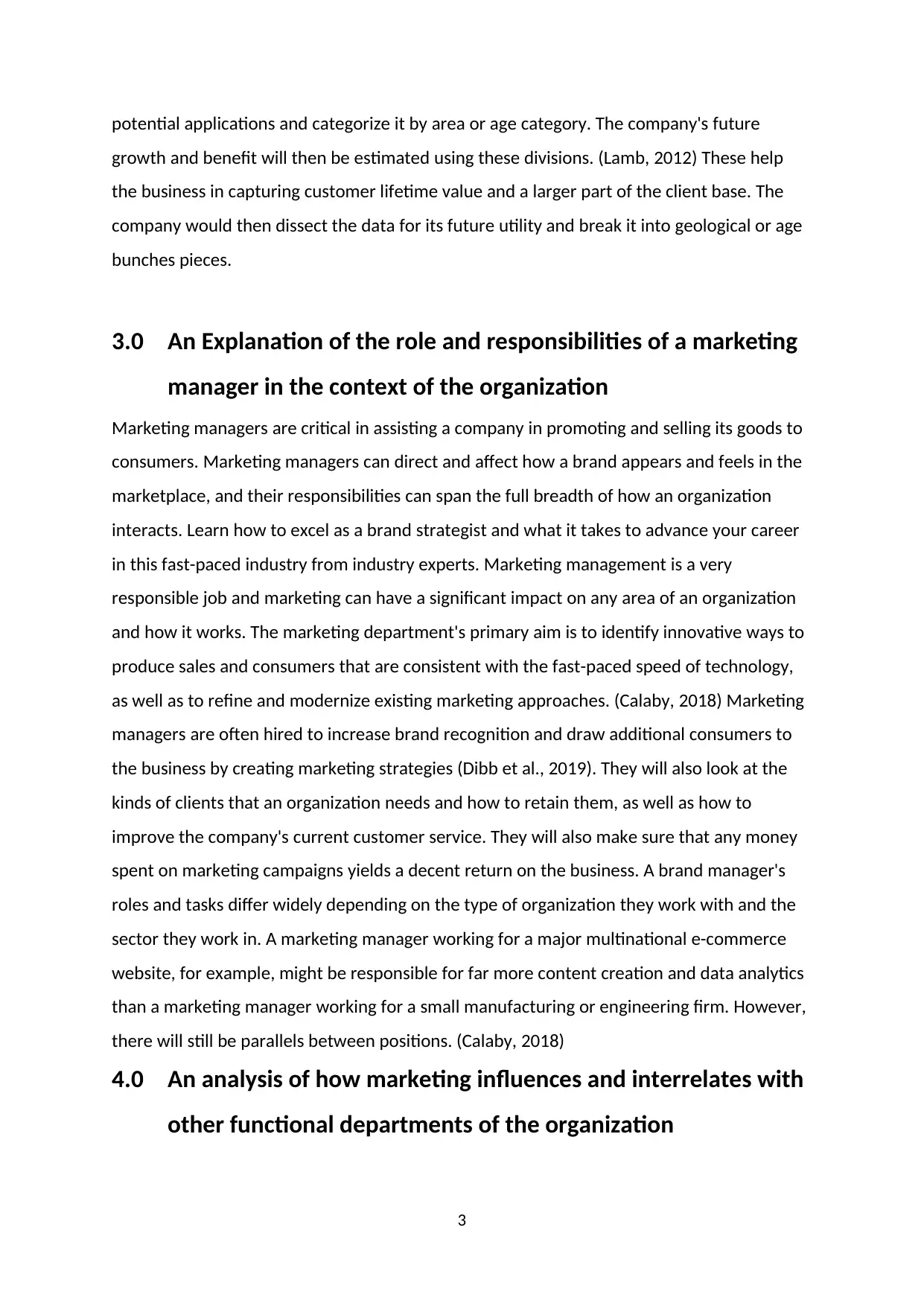
potential applications and categorize it by area or age category. The company's future
growth and benefit will then be estimated using these divisions. (Lamb, 2012) These help
the business in capturing customer lifetime value and a larger part of the client base. The
company would then dissect the data for its future utility and break it into geological or age
bunches pieces.
3.0 An Explanation of the role and responsibilities of a marketing
manager in the context of the organization
Marketing managers are critical in assisting a company in promoting and selling its goods to
consumers. Marketing managers can direct and affect how a brand appears and feels in the
marketplace, and their responsibilities can span the full breadth of how an organization
interacts. Learn how to excel as a brand strategist and what it takes to advance your career
in this fast-paced industry from industry experts. Marketing management is a very
responsible job and marketing can have a significant impact on any area of an organization
and how it works. The marketing department's primary aim is to identify innovative ways to
produce sales and consumers that are consistent with the fast-paced speed of technology,
as well as to refine and modernize existing marketing approaches. (Calaby, 2018) Marketing
managers are often hired to increase brand recognition and draw additional consumers to
the business by creating marketing strategies (Dibb et al., 2019). They will also look at the
kinds of clients that an organization needs and how to retain them, as well as how to
improve the company's current customer service. They will also make sure that any money
spent on marketing campaigns yields a decent return on the business. A brand manager's
roles and tasks differ widely depending on the type of organization they work with and the
sector they work in. A marketing manager working for a major multinational e-commerce
website, for example, might be responsible for far more content creation and data analytics
than a marketing manager working for a small manufacturing or engineering firm. However,
there will still be parallels between positions. (Calaby, 2018)
4.0 An analysis of how marketing influences and interrelates with
other functional departments of the organization
3
growth and benefit will then be estimated using these divisions. (Lamb, 2012) These help
the business in capturing customer lifetime value and a larger part of the client base. The
company would then dissect the data for its future utility and break it into geological or age
bunches pieces.
3.0 An Explanation of the role and responsibilities of a marketing
manager in the context of the organization
Marketing managers are critical in assisting a company in promoting and selling its goods to
consumers. Marketing managers can direct and affect how a brand appears and feels in the
marketplace, and their responsibilities can span the full breadth of how an organization
interacts. Learn how to excel as a brand strategist and what it takes to advance your career
in this fast-paced industry from industry experts. Marketing management is a very
responsible job and marketing can have a significant impact on any area of an organization
and how it works. The marketing department's primary aim is to identify innovative ways to
produce sales and consumers that are consistent with the fast-paced speed of technology,
as well as to refine and modernize existing marketing approaches. (Calaby, 2018) Marketing
managers are often hired to increase brand recognition and draw additional consumers to
the business by creating marketing strategies (Dibb et al., 2019). They will also look at the
kinds of clients that an organization needs and how to retain them, as well as how to
improve the company's current customer service. They will also make sure that any money
spent on marketing campaigns yields a decent return on the business. A brand manager's
roles and tasks differ widely depending on the type of organization they work with and the
sector they work in. A marketing manager working for a major multinational e-commerce
website, for example, might be responsible for far more content creation and data analytics
than a marketing manager working for a small manufacturing or engineering firm. However,
there will still be parallels between positions. (Calaby, 2018)
4.0 An analysis of how marketing influences and interrelates with
other functional departments of the organization
3
Paraphrase This Document
Need a fresh take? Get an instant paraphrase of this document with our AI Paraphraser
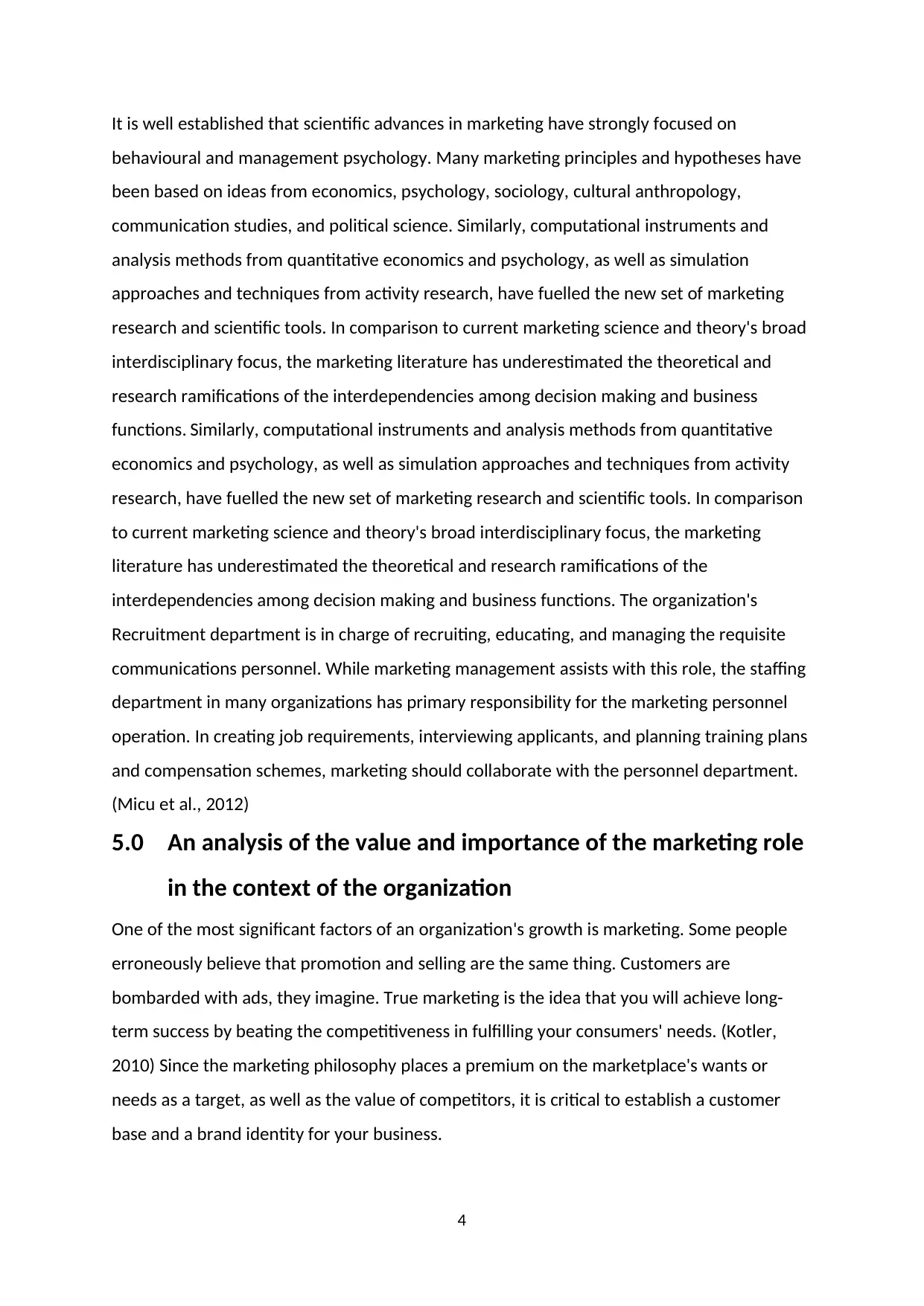
It is well established that scientific advances in marketing have strongly focused on
behavioural and management psychology. Many marketing principles and hypotheses have
been based on ideas from economics, psychology, sociology, cultural anthropology,
communication studies, and political science. Similarly, computational instruments and
analysis methods from quantitative economics and psychology, as well as simulation
approaches and techniques from activity research, have fuelled the new set of marketing
research and scientific tools. In comparison to current marketing science and theory's broad
interdisciplinary focus, the marketing literature has underestimated the theoretical and
research ramifications of the interdependencies among decision making and business
functions. Similarly, computational instruments and analysis methods from quantitative
economics and psychology, as well as simulation approaches and techniques from activity
research, have fuelled the new set of marketing research and scientific tools. In comparison
to current marketing science and theory's broad interdisciplinary focus, the marketing
literature has underestimated the theoretical and research ramifications of the
interdependencies among decision making and business functions. The organization's
Recruitment department is in charge of recruiting, educating, and managing the requisite
communications personnel. While marketing management assists with this role, the staffing
department in many organizations has primary responsibility for the marketing personnel
operation. In creating job requirements, interviewing applicants, and planning training plans
and compensation schemes, marketing should collaborate with the personnel department.
(Micu et al., 2012)
5.0 An analysis of the value and importance of the marketing role
in the context of the organization
One of the most significant factors of an organization's growth is marketing. Some people
erroneously believe that promotion and selling are the same thing. Customers are
bombarded with ads, they imagine. True marketing is the idea that you will achieve long-
term success by beating the competitiveness in fulfilling your consumers' needs. (Kotler,
2010) Since the marketing philosophy places a premium on the marketplace's wants or
needs as a target, as well as the value of competitors, it is critical to establish a customer
base and a brand identity for your business.
4
behavioural and management psychology. Many marketing principles and hypotheses have
been based on ideas from economics, psychology, sociology, cultural anthropology,
communication studies, and political science. Similarly, computational instruments and
analysis methods from quantitative economics and psychology, as well as simulation
approaches and techniques from activity research, have fuelled the new set of marketing
research and scientific tools. In comparison to current marketing science and theory's broad
interdisciplinary focus, the marketing literature has underestimated the theoretical and
research ramifications of the interdependencies among decision making and business
functions. Similarly, computational instruments and analysis methods from quantitative
economics and psychology, as well as simulation approaches and techniques from activity
research, have fuelled the new set of marketing research and scientific tools. In comparison
to current marketing science and theory's broad interdisciplinary focus, the marketing
literature has underestimated the theoretical and research ramifications of the
interdependencies among decision making and business functions. The organization's
Recruitment department is in charge of recruiting, educating, and managing the requisite
communications personnel. While marketing management assists with this role, the staffing
department in many organizations has primary responsibility for the marketing personnel
operation. In creating job requirements, interviewing applicants, and planning training plans
and compensation schemes, marketing should collaborate with the personnel department.
(Micu et al., 2012)
5.0 An analysis of the value and importance of the marketing role
in the context of the organization
One of the most significant factors of an organization's growth is marketing. Some people
erroneously believe that promotion and selling are the same thing. Customers are
bombarded with ads, they imagine. True marketing is the idea that you will achieve long-
term success by beating the competitiveness in fulfilling your consumers' needs. (Kotler,
2010) Since the marketing philosophy places a premium on the marketplace's wants or
needs as a target, as well as the value of competitors, it is critical to establish a customer
base and a brand identity for your business.
4
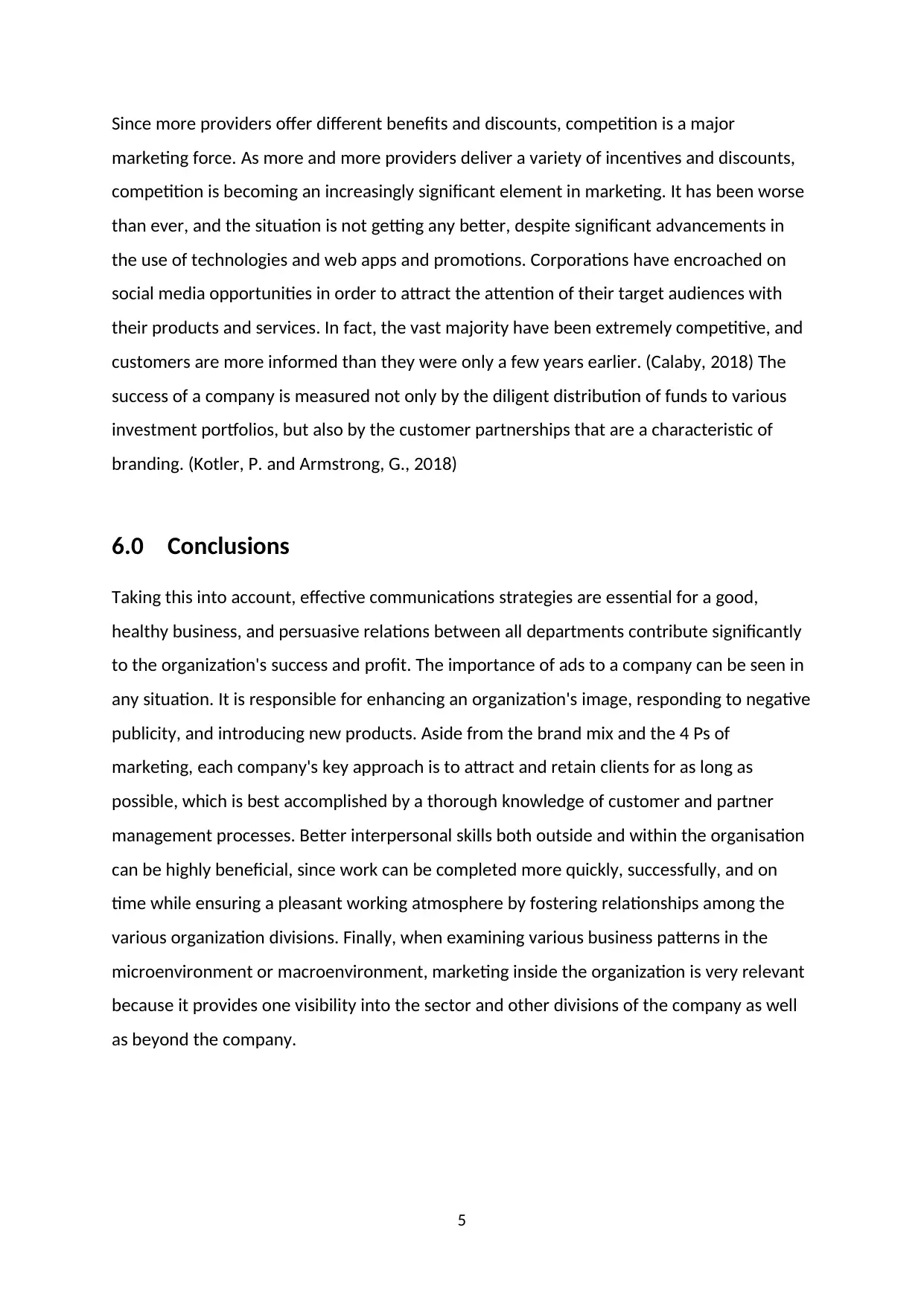
Since more providers offer different benefits and discounts, competition is a major
marketing force. As more and more providers deliver a variety of incentives and discounts,
competition is becoming an increasingly significant element in marketing. It has been worse
than ever, and the situation is not getting any better, despite significant advancements in
the use of technologies and web apps and promotions. Corporations have encroached on
social media opportunities in order to attract the attention of their target audiences with
their products and services. In fact, the vast majority have been extremely competitive, and
customers are more informed than they were only a few years earlier. (Calaby, 2018) The
success of a company is measured not only by the diligent distribution of funds to various
investment portfolios, but also by the customer partnerships that are a characteristic of
branding. (Kotler, P. and Armstrong, G., 2018)
6.0 Conclusions
Taking this into account, effective communications strategies are essential for a good,
healthy business, and persuasive relations between all departments contribute significantly
to the organization's success and profit. The importance of ads to a company can be seen in
any situation. It is responsible for enhancing an organization's image, responding to negative
publicity, and introducing new products. Aside from the brand mix and the 4 Ps of
marketing, each company's key approach is to attract and retain clients for as long as
possible, which is best accomplished by a thorough knowledge of customer and partner
management processes. Better interpersonal skills both outside and within the organisation
can be highly beneficial, since work can be completed more quickly, successfully, and on
time while ensuring a pleasant working atmosphere by fostering relationships among the
various organization divisions. Finally, when examining various business patterns in the
microenvironment or macroenvironment, marketing inside the organization is very relevant
because it provides one visibility into the sector and other divisions of the company as well
as beyond the company.
5
marketing force. As more and more providers deliver a variety of incentives and discounts,
competition is becoming an increasingly significant element in marketing. It has been worse
than ever, and the situation is not getting any better, despite significant advancements in
the use of technologies and web apps and promotions. Corporations have encroached on
social media opportunities in order to attract the attention of their target audiences with
their products and services. In fact, the vast majority have been extremely competitive, and
customers are more informed than they were only a few years earlier. (Calaby, 2018) The
success of a company is measured not only by the diligent distribution of funds to various
investment portfolios, but also by the customer partnerships that are a characteristic of
branding. (Kotler, P. and Armstrong, G., 2018)
6.0 Conclusions
Taking this into account, effective communications strategies are essential for a good,
healthy business, and persuasive relations between all departments contribute significantly
to the organization's success and profit. The importance of ads to a company can be seen in
any situation. It is responsible for enhancing an organization's image, responding to negative
publicity, and introducing new products. Aside from the brand mix and the 4 Ps of
marketing, each company's key approach is to attract and retain clients for as long as
possible, which is best accomplished by a thorough knowledge of customer and partner
management processes. Better interpersonal skills both outside and within the organisation
can be highly beneficial, since work can be completed more quickly, successfully, and on
time while ensuring a pleasant working atmosphere by fostering relationships among the
various organization divisions. Finally, when examining various business patterns in the
microenvironment or macroenvironment, marketing inside the organization is very relevant
because it provides one visibility into the sector and other divisions of the company as well
as beyond the company.
5
⊘ This is a preview!⊘
Do you want full access?
Subscribe today to unlock all pages.

Trusted by 1+ million students worldwide
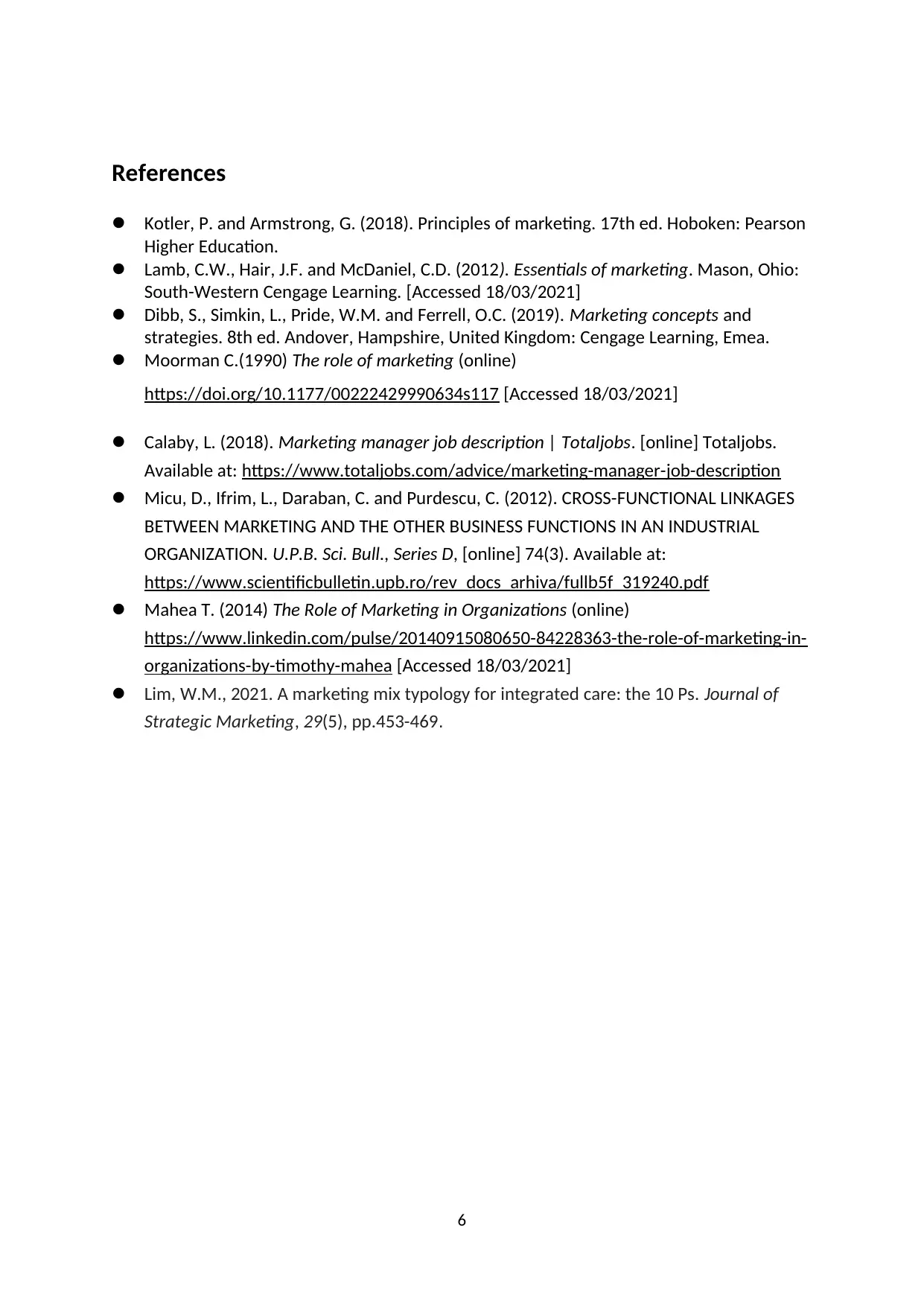
References
Kotler, P. and Armstrong, G. (2018). Principles of marketing. 17th ed. Hoboken: Pearson
Higher Education.
Lamb, C.W., Hair, J.F. and McDaniel, C.D. (2012). Essentials of marketing. Mason, Ohio:
South-Western Cengage Learning. [Accessed 18/03/2021]
Dibb, S., Simkin, L., Pride, W.M. and Ferrell, O.C. (2019). Marketing concepts and
strategies. 8th ed. Andover, Hampshire, United Kingdom: Cengage Learning, Emea.
Moorman C.(1990) The role of marketing (online)
https://doi.org/10.1177/00222429990634s117 [Accessed 18/03/2021]
Calaby, L. (2018). Marketing manager job description | Totaljobs. [online] Totaljobs.
Available at: https://www.totaljobs.com/advice/marketing-manager-job-description
Micu, D., Ifrim, L., Daraban, C. and Purdescu, C. (2012). CROSS-FUNCTIONAL LINKAGES
BETWEEN MARKETING AND THE OTHER BUSINESS FUNCTIONS IN AN INDUSTRIAL
ORGANIZATION. U.P.B. Sci. Bull., Series D, [online] 74(3). Available at:
https://www.scientificbulletin.upb.ro/rev_docs_arhiva/fullb5f_319240.pdf
Mahea T. (2014) The Role of Marketing in Organizations (online)
https://www.linkedin.com/pulse/20140915080650-84228363-the-role-of-marketing-in-
organizations-by-timothy-mahea [Accessed 18/03/2021]
Lim, W.M., 2021. A marketing mix typology for integrated care: the 10 Ps. Journal of
Strategic Marketing, 29(5), pp.453-469.
6
Kotler, P. and Armstrong, G. (2018). Principles of marketing. 17th ed. Hoboken: Pearson
Higher Education.
Lamb, C.W., Hair, J.F. and McDaniel, C.D. (2012). Essentials of marketing. Mason, Ohio:
South-Western Cengage Learning. [Accessed 18/03/2021]
Dibb, S., Simkin, L., Pride, W.M. and Ferrell, O.C. (2019). Marketing concepts and
strategies. 8th ed. Andover, Hampshire, United Kingdom: Cengage Learning, Emea.
Moorman C.(1990) The role of marketing (online)
https://doi.org/10.1177/00222429990634s117 [Accessed 18/03/2021]
Calaby, L. (2018). Marketing manager job description | Totaljobs. [online] Totaljobs.
Available at: https://www.totaljobs.com/advice/marketing-manager-job-description
Micu, D., Ifrim, L., Daraban, C. and Purdescu, C. (2012). CROSS-FUNCTIONAL LINKAGES
BETWEEN MARKETING AND THE OTHER BUSINESS FUNCTIONS IN AN INDUSTRIAL
ORGANIZATION. U.P.B. Sci. Bull., Series D, [online] 74(3). Available at:
https://www.scientificbulletin.upb.ro/rev_docs_arhiva/fullb5f_319240.pdf
Mahea T. (2014) The Role of Marketing in Organizations (online)
https://www.linkedin.com/pulse/20140915080650-84228363-the-role-of-marketing-in-
organizations-by-timothy-mahea [Accessed 18/03/2021]
Lim, W.M., 2021. A marketing mix typology for integrated care: the 10 Ps. Journal of
Strategic Marketing, 29(5), pp.453-469.
6
Paraphrase This Document
Need a fresh take? Get an instant paraphrase of this document with our AI Paraphraser
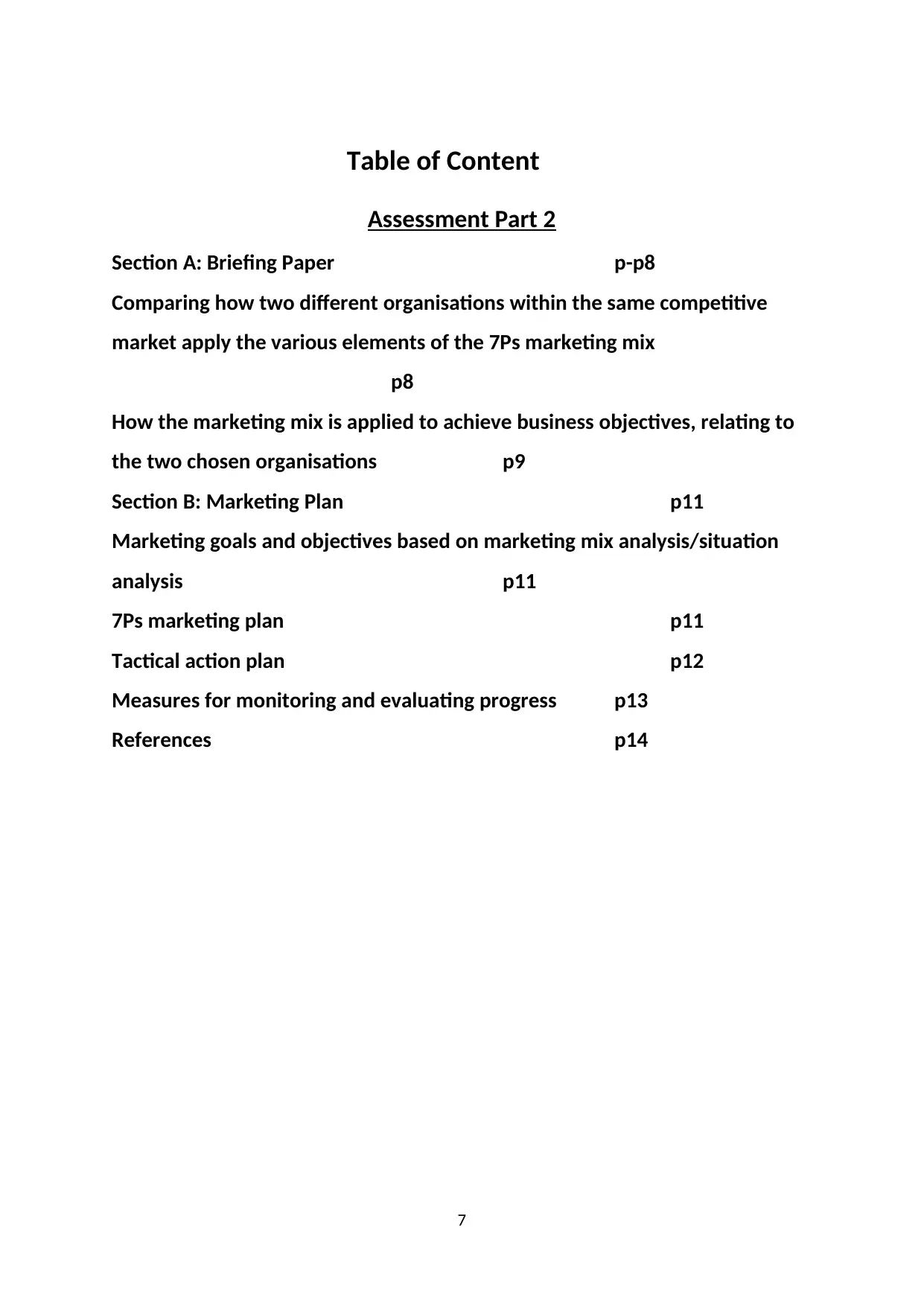
Table of Content
Assessment Part 2
Section A: Briefing Paper p-p8
Comparing how two different organisations within the same competitive
market apply the various elements of the 7Ps marketing mix
p8
How the marketing mix is applied to achieve business objectives, relating to
the two chosen organisations p9
Section B: Marketing Plan p11
Marketing goals and objectives based on marketing mix analysis/situation
analysis p11
7Ps marketing plan p11
Tactical action plan p12
Measures for monitoring and evaluating progress p13
References p14
7
Assessment Part 2
Section A: Briefing Paper p-p8
Comparing how two different organisations within the same competitive
market apply the various elements of the 7Ps marketing mix
p8
How the marketing mix is applied to achieve business objectives, relating to
the two chosen organisations p9
Section B: Marketing Plan p11
Marketing goals and objectives based on marketing mix analysis/situation
analysis p11
7Ps marketing plan p11
Tactical action plan p12
Measures for monitoring and evaluating progress p13
References p14
7
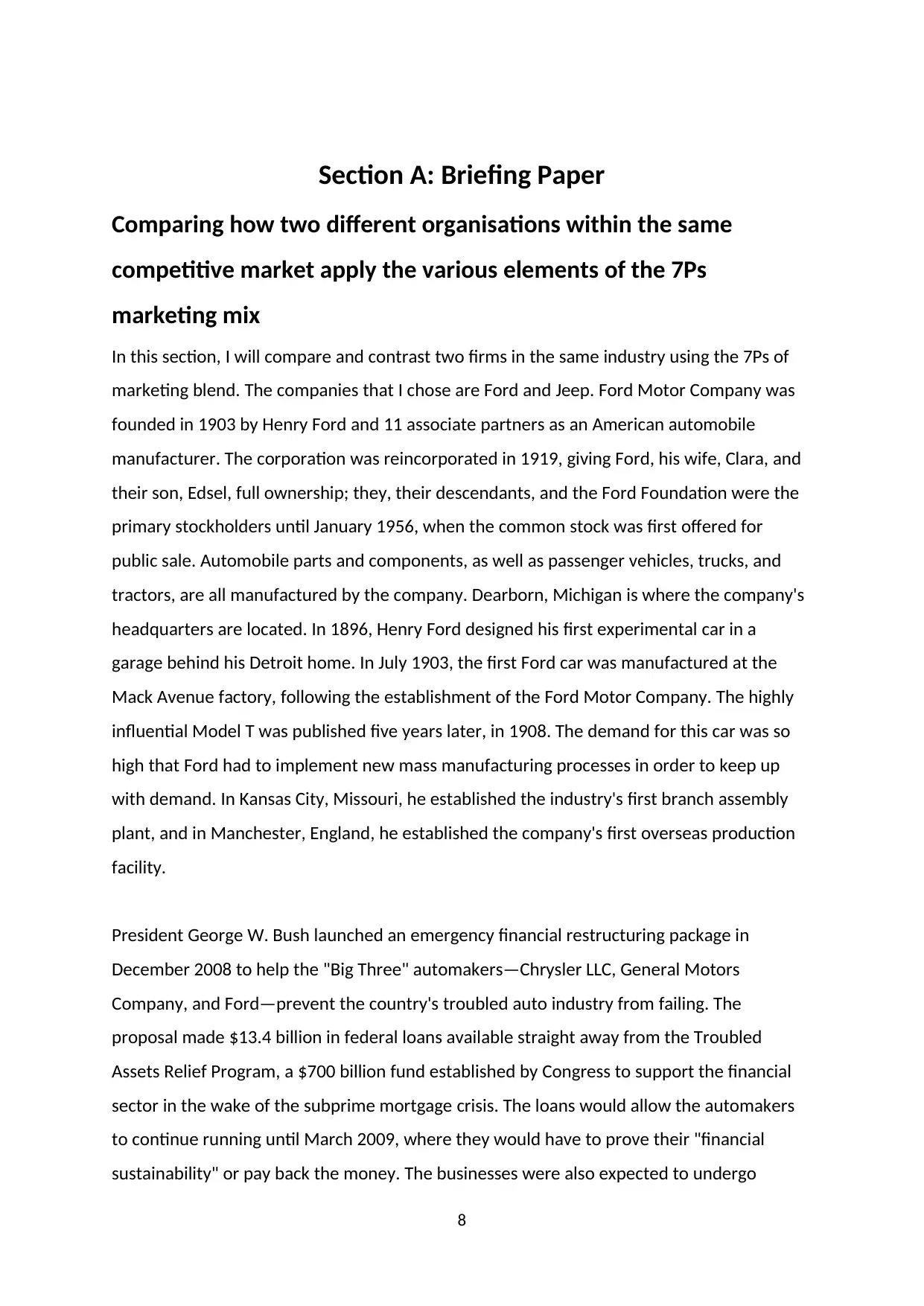
Section A: Briefing Paper
Comparing how two different organisations within the same
competitive market apply the various elements of the 7Ps
marketing mix
In this section, I will compare and contrast two firms in the same industry using the 7Ps of
marketing blend. The companies that I chose are Ford and Jeep. Ford Motor Company was
founded in 1903 by Henry Ford and 11 associate partners as an American automobile
manufacturer. The corporation was reincorporated in 1919, giving Ford, his wife, Clara, and
their son, Edsel, full ownership; they, their descendants, and the Ford Foundation were the
primary stockholders until January 1956, when the common stock was first offered for
public sale. Automobile parts and components, as well as passenger vehicles, trucks, and
tractors, are all manufactured by the company. Dearborn, Michigan is where the company's
headquarters are located. In 1896, Henry Ford designed his first experimental car in a
garage behind his Detroit home. In July 1903, the first Ford car was manufactured at the
Mack Avenue factory, following the establishment of the Ford Motor Company. The highly
influential Model T was published five years later, in 1908. The demand for this car was so
high that Ford had to implement new mass manufacturing processes in order to keep up
with demand. In Kansas City, Missouri, he established the industry's first branch assembly
plant, and in Manchester, England, he established the company's first overseas production
facility.
President George W. Bush launched an emergency financial restructuring package in
December 2008 to help the "Big Three" automakers—Chrysler LLC, General Motors
Company, and Ford—prevent the country's troubled auto industry from failing. The
proposal made $13.4 billion in federal loans available straight away from the Troubled
Assets Relief Program, a $700 billion fund established by Congress to support the financial
sector in the wake of the subprime mortgage crisis. The loans would allow the automakers
to continue running until March 2009, where they would have to prove their "financial
sustainability" or pay back the money. The businesses were also expected to undergo
8
Comparing how two different organisations within the same
competitive market apply the various elements of the 7Ps
marketing mix
In this section, I will compare and contrast two firms in the same industry using the 7Ps of
marketing blend. The companies that I chose are Ford and Jeep. Ford Motor Company was
founded in 1903 by Henry Ford and 11 associate partners as an American automobile
manufacturer. The corporation was reincorporated in 1919, giving Ford, his wife, Clara, and
their son, Edsel, full ownership; they, their descendants, and the Ford Foundation were the
primary stockholders until January 1956, when the common stock was first offered for
public sale. Automobile parts and components, as well as passenger vehicles, trucks, and
tractors, are all manufactured by the company. Dearborn, Michigan is where the company's
headquarters are located. In 1896, Henry Ford designed his first experimental car in a
garage behind his Detroit home. In July 1903, the first Ford car was manufactured at the
Mack Avenue factory, following the establishment of the Ford Motor Company. The highly
influential Model T was published five years later, in 1908. The demand for this car was so
high that Ford had to implement new mass manufacturing processes in order to keep up
with demand. In Kansas City, Missouri, he established the industry's first branch assembly
plant, and in Manchester, England, he established the company's first overseas production
facility.
President George W. Bush launched an emergency financial restructuring package in
December 2008 to help the "Big Three" automakers—Chrysler LLC, General Motors
Company, and Ford—prevent the country's troubled auto industry from failing. The
proposal made $13.4 billion in federal loans available straight away from the Troubled
Assets Relief Program, a $700 billion fund established by Congress to support the financial
sector in the wake of the subprime mortgage crisis. The loans would allow the automakers
to continue running until March 2009, where they would have to prove their "financial
sustainability" or pay back the money. The businesses were also expected to undergo
8
⊘ This is a preview!⊘
Do you want full access?
Subscribe today to unlock all pages.

Trusted by 1+ million students worldwide
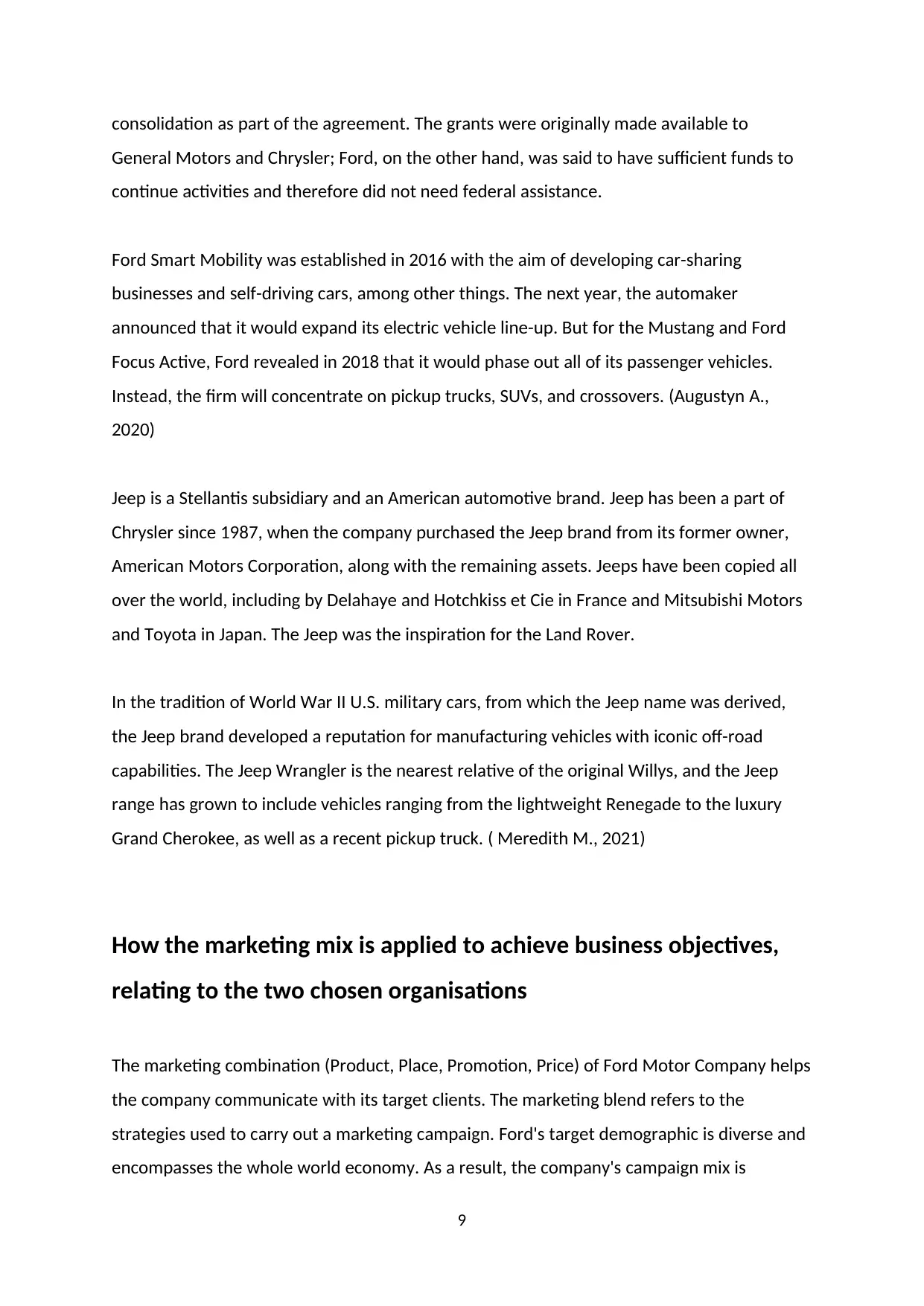
consolidation as part of the agreement. The grants were originally made available to
General Motors and Chrysler; Ford, on the other hand, was said to have sufficient funds to
continue activities and therefore did not need federal assistance.
Ford Smart Mobility was established in 2016 with the aim of developing car-sharing
businesses and self-driving cars, among other things. The next year, the automaker
announced that it would expand its electric vehicle line-up. But for the Mustang and Ford
Focus Active, Ford revealed in 2018 that it would phase out all of its passenger vehicles.
Instead, the firm will concentrate on pickup trucks, SUVs, and crossovers. (Augustyn A.,
2020)
Jeep is a Stellantis subsidiary and an American automotive brand. Jeep has been a part of
Chrysler since 1987, when the company purchased the Jeep brand from its former owner,
American Motors Corporation, along with the remaining assets. Jeeps have been copied all
over the world, including by Delahaye and Hotchkiss et Cie in France and Mitsubishi Motors
and Toyota in Japan. The Jeep was the inspiration for the Land Rover.
In the tradition of World War II U.S. military cars, from which the Jeep name was derived,
the Jeep brand developed a reputation for manufacturing vehicles with iconic off-road
capabilities. The Jeep Wrangler is the nearest relative of the original Willys, and the Jeep
range has grown to include vehicles ranging from the lightweight Renegade to the luxury
Grand Cherokee, as well as a recent pickup truck. ( Meredith M., 2021)
How the marketing mix is applied to achieve business objectives,
relating to the two chosen organisations
The marketing combination (Product, Place, Promotion, Price) of Ford Motor Company helps
the company communicate with its target clients. The marketing blend refers to the
strategies used to carry out a marketing campaign. Ford's target demographic is diverse and
encompasses the whole world economy. As a result, the company's campaign mix is
9
General Motors and Chrysler; Ford, on the other hand, was said to have sufficient funds to
continue activities and therefore did not need federal assistance.
Ford Smart Mobility was established in 2016 with the aim of developing car-sharing
businesses and self-driving cars, among other things. The next year, the automaker
announced that it would expand its electric vehicle line-up. But for the Mustang and Ford
Focus Active, Ford revealed in 2018 that it would phase out all of its passenger vehicles.
Instead, the firm will concentrate on pickup trucks, SUVs, and crossovers. (Augustyn A.,
2020)
Jeep is a Stellantis subsidiary and an American automotive brand. Jeep has been a part of
Chrysler since 1987, when the company purchased the Jeep brand from its former owner,
American Motors Corporation, along with the remaining assets. Jeeps have been copied all
over the world, including by Delahaye and Hotchkiss et Cie in France and Mitsubishi Motors
and Toyota in Japan. The Jeep was the inspiration for the Land Rover.
In the tradition of World War II U.S. military cars, from which the Jeep name was derived,
the Jeep brand developed a reputation for manufacturing vehicles with iconic off-road
capabilities. The Jeep Wrangler is the nearest relative of the original Willys, and the Jeep
range has grown to include vehicles ranging from the lightweight Renegade to the luxury
Grand Cherokee, as well as a recent pickup truck. ( Meredith M., 2021)
How the marketing mix is applied to achieve business objectives,
relating to the two chosen organisations
The marketing combination (Product, Place, Promotion, Price) of Ford Motor Company helps
the company communicate with its target clients. The marketing blend refers to the
strategies used to carry out a marketing campaign. Ford's target demographic is diverse and
encompasses the whole world economy. As a result, the company's campaign mix is
9
Paraphrase This Document
Need a fresh take? Get an instant paraphrase of this document with our AI Paraphraser
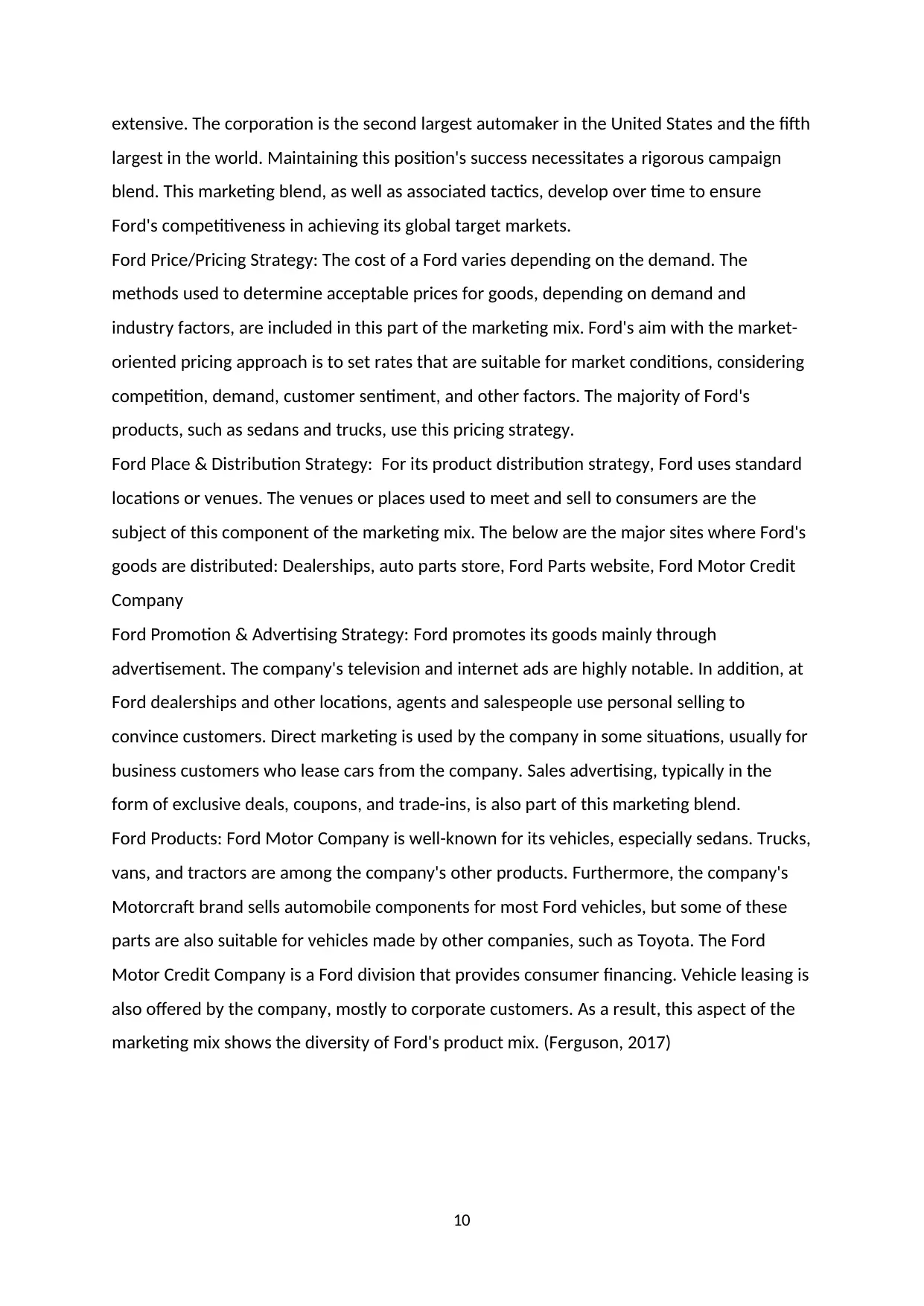
extensive. The corporation is the second largest automaker in the United States and the fifth
largest in the world. Maintaining this position's success necessitates a rigorous campaign
blend. This marketing blend, as well as associated tactics, develop over time to ensure
Ford's competitiveness in achieving its global target markets.
Ford Price/Pricing Strategy: The cost of a Ford varies depending on the demand. The
methods used to determine acceptable prices for goods, depending on demand and
industry factors, are included in this part of the marketing mix. Ford's aim with the market-
oriented pricing approach is to set rates that are suitable for market conditions, considering
competition, demand, customer sentiment, and other factors. The majority of Ford's
products, such as sedans and trucks, use this pricing strategy.
Ford Place & Distribution Strategy: For its product distribution strategy, Ford uses standard
locations or venues. The venues or places used to meet and sell to consumers are the
subject of this component of the marketing mix. The below are the major sites where Ford's
goods are distributed: Dealerships, auto parts store, Ford Parts website, Ford Motor Credit
Company
Ford Promotion & Advertising Strategy: Ford promotes its goods mainly through
advertisement. The company's television and internet ads are highly notable. In addition, at
Ford dealerships and other locations, agents and salespeople use personal selling to
convince customers. Direct marketing is used by the company in some situations, usually for
business customers who lease cars from the company. Sales advertising, typically in the
form of exclusive deals, coupons, and trade-ins, is also part of this marketing blend.
Ford Products: Ford Motor Company is well-known for its vehicles, especially sedans. Trucks,
vans, and tractors are among the company's other products. Furthermore, the company's
Motorcraft brand sells automobile components for most Ford vehicles, but some of these
parts are also suitable for vehicles made by other companies, such as Toyota. The Ford
Motor Credit Company is a Ford division that provides consumer financing. Vehicle leasing is
also offered by the company, mostly to corporate customers. As a result, this aspect of the
marketing mix shows the diversity of Ford's product mix. (Ferguson, 2017)
10
largest in the world. Maintaining this position's success necessitates a rigorous campaign
blend. This marketing blend, as well as associated tactics, develop over time to ensure
Ford's competitiveness in achieving its global target markets.
Ford Price/Pricing Strategy: The cost of a Ford varies depending on the demand. The
methods used to determine acceptable prices for goods, depending on demand and
industry factors, are included in this part of the marketing mix. Ford's aim with the market-
oriented pricing approach is to set rates that are suitable for market conditions, considering
competition, demand, customer sentiment, and other factors. The majority of Ford's
products, such as sedans and trucks, use this pricing strategy.
Ford Place & Distribution Strategy: For its product distribution strategy, Ford uses standard
locations or venues. The venues or places used to meet and sell to consumers are the
subject of this component of the marketing mix. The below are the major sites where Ford's
goods are distributed: Dealerships, auto parts store, Ford Parts website, Ford Motor Credit
Company
Ford Promotion & Advertising Strategy: Ford promotes its goods mainly through
advertisement. The company's television and internet ads are highly notable. In addition, at
Ford dealerships and other locations, agents and salespeople use personal selling to
convince customers. Direct marketing is used by the company in some situations, usually for
business customers who lease cars from the company. Sales advertising, typically in the
form of exclusive deals, coupons, and trade-ins, is also part of this marketing blend.
Ford Products: Ford Motor Company is well-known for its vehicles, especially sedans. Trucks,
vans, and tractors are among the company's other products. Furthermore, the company's
Motorcraft brand sells automobile components for most Ford vehicles, but some of these
parts are also suitable for vehicles made by other companies, such as Toyota. The Ford
Motor Credit Company is a Ford division that provides consumer financing. Vehicle leasing is
also offered by the company, mostly to corporate customers. As a result, this aspect of the
marketing mix shows the diversity of Ford's product mix. (Ferguson, 2017)
10
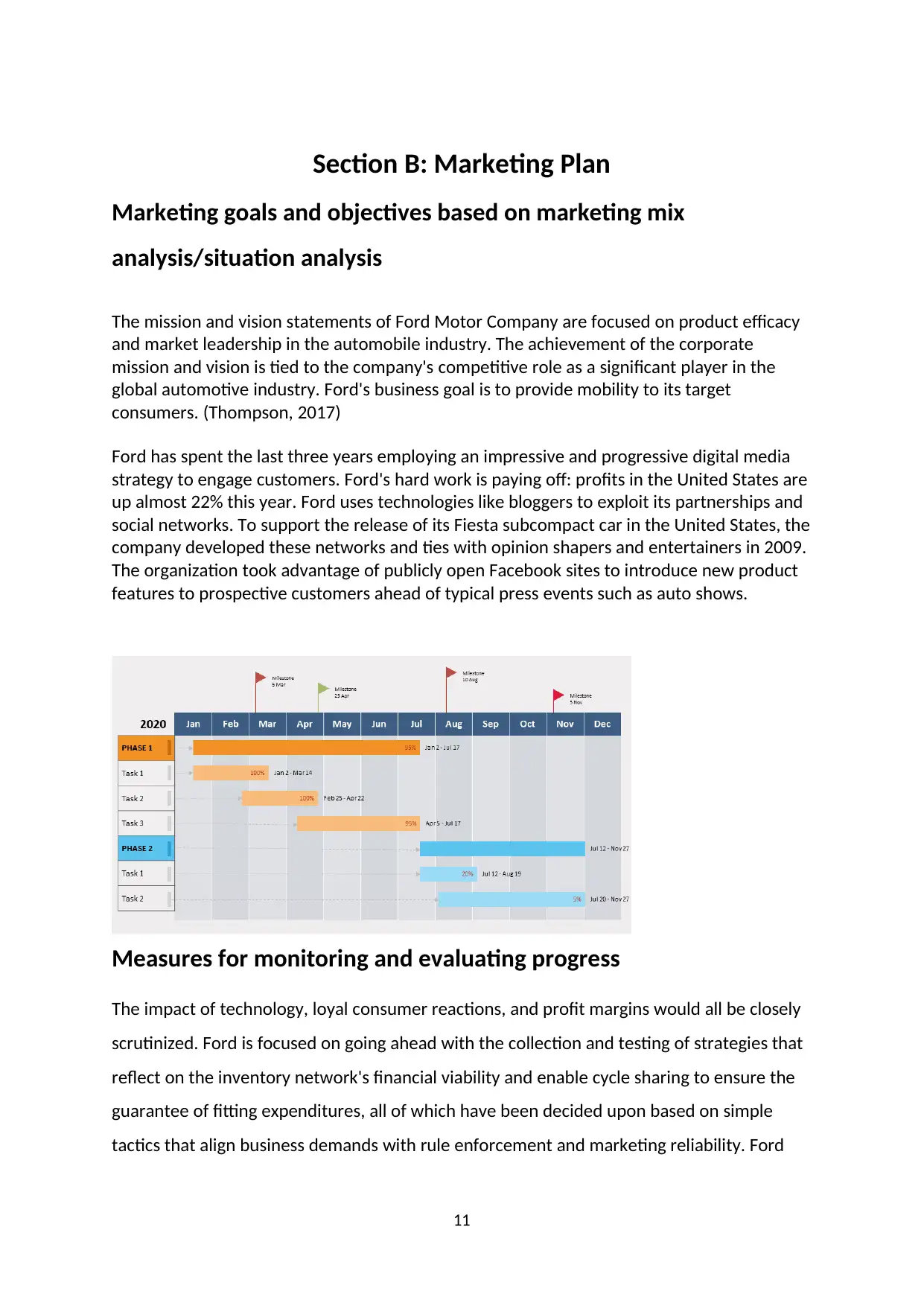
Section B: Marketing Plan
Marketing goals and objectives based on marketing mix
analysis/situation analysis
The mission and vision statements of Ford Motor Company are focused on product efficacy
and market leadership in the automobile industry. The achievement of the corporate
mission and vision is tied to the company's competitive role as a significant player in the
global automotive industry. Ford's business goal is to provide mobility to its target
consumers. (Thompson, 2017)
Ford has spent the last three years employing an impressive and progressive digital media
strategy to engage customers. Ford's hard work is paying off: profits in the United States are
up almost 22% this year. Ford uses technologies like bloggers to exploit its partnerships and
social networks. To support the release of its Fiesta subcompact car in the United States, the
company developed these networks and ties with opinion shapers and entertainers in 2009.
The organization took advantage of publicly open Facebook sites to introduce new product
features to prospective customers ahead of typical press events such as auto shows.
Measures for monitoring and evaluating progress
The impact of technology, loyal consumer reactions, and profit margins would all be closely
scrutinized. Ford is focused on going ahead with the collection and testing of strategies that
reflect on the inventory network's financial viability and enable cycle sharing to ensure the
guarantee of fitting expenditures, all of which have been decided upon based on simple
tactics that align business demands with rule enforcement and marketing reliability. Ford
11
Marketing goals and objectives based on marketing mix
analysis/situation analysis
The mission and vision statements of Ford Motor Company are focused on product efficacy
and market leadership in the automobile industry. The achievement of the corporate
mission and vision is tied to the company's competitive role as a significant player in the
global automotive industry. Ford's business goal is to provide mobility to its target
consumers. (Thompson, 2017)
Ford has spent the last three years employing an impressive and progressive digital media
strategy to engage customers. Ford's hard work is paying off: profits in the United States are
up almost 22% this year. Ford uses technologies like bloggers to exploit its partnerships and
social networks. To support the release of its Fiesta subcompact car in the United States, the
company developed these networks and ties with opinion shapers and entertainers in 2009.
The organization took advantage of publicly open Facebook sites to introduce new product
features to prospective customers ahead of typical press events such as auto shows.
Measures for monitoring and evaluating progress
The impact of technology, loyal consumer reactions, and profit margins would all be closely
scrutinized. Ford is focused on going ahead with the collection and testing of strategies that
reflect on the inventory network's financial viability and enable cycle sharing to ensure the
guarantee of fitting expenditures, all of which have been decided upon based on simple
tactics that align business demands with rule enforcement and marketing reliability. Ford
11
⊘ This is a preview!⊘
Do you want full access?
Subscribe today to unlock all pages.

Trusted by 1+ million students worldwide
1 out of 15
Related Documents
Your All-in-One AI-Powered Toolkit for Academic Success.
+13062052269
info@desklib.com
Available 24*7 on WhatsApp / Email
![[object Object]](/_next/static/media/star-bottom.7253800d.svg)
Unlock your academic potential
Copyright © 2020–2025 A2Z Services. All Rights Reserved. Developed and managed by ZUCOL.




